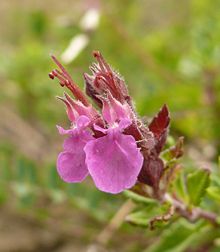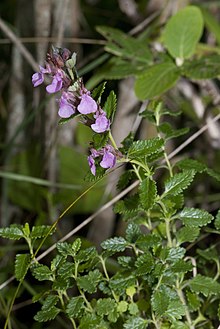Noble germander
| Noble germander | ||||||||||||
|---|---|---|---|---|---|---|---|---|---|---|---|---|

Noble germander ( Teucrium chamaedrys ) |
||||||||||||
| Systematics | ||||||||||||
|
||||||||||||
| Scientific name | ||||||||||||
| Teucrium chamaedrys | ||||||||||||
| L. |
The noble germander , real germander or sheepweed ( Teucrium chamaedrys ) is a mint (Lamiaceae) from the genus of the germander ( Teucrium ).
description
The noble germander is a subshrub with runners . The stem is 10 to 30 (up to 35) cm high, ascending, woody in the lower part, branched below, hairy all around or on the opposite sides short and long protruding. The leaves are short-stalked or almost sessile, oval, usually with a wedge-shaped narrowed leaf base, on each leaf side with four to eight blunt or pointed teeth, usually hairy on both sides.
The flowers are about 3 mm long stalked, one to six in the axils of the upper leaves, and are one-sided. The calyx is 6 to 8 mm long, more or less regularly five-toothed, hairy, often tinged with red-violet. The corolla is 1 to 1.5 cm long, pink (rarely white). The partial fruits have a fine-veined surface and are approx. 1.5 to 2 mm long. The plant smells pleasantly aromatic.
The number of chromosomes is 2n = 60, 64 or 96.
Occurrence
The noble germander grows scattered and usually sociable in sunny, lime-grain lawns as well as in light oak and pine forests. In Central Europe it is a species of the order Brometalia, but also occurs in societies of the Geranion sanguinei, Erico-Pinion or the order Quercetalia pubescentis associations. It loves base-rich, extremely low-nitrogen soil and is an indicator of drought and a warmth-loving light plant. It is more strongly represented in southern Germany.
ecology
The precious germander is only woody at the base, creeping shrub . It is adapted to drought and has roots up to 1.2 m deep, its leaves are coarse and wintergreen and its stem is shaggy and hairy. The plant is rich in antiperspirant essential oils.
The flowers are pre-male "real lip flowers" and are in four to six-flowered pseudo whorls in the axils of the upper leaves. The corolla is short and has no hair ring; it is bright red with a short, two-column upper lip, which is connected to the lower lip, so that it appears to have five columns. The flowers are weakly fragrant. The stamens are initially directed forwards, later - when the stylus points forwards - upwards. The pollen is pink. The species is of particular value as a nectar dispenser. Pollinators are bumblebees , bees and hoverflies . Spontaneous self-pollination is not very effective. Flowering period: July to September.
The Klausen-fruits are surrounded maturity from inflated calyx, which serves as a wind passage. The plant is a wind spreader, possibly also an animal spreader.
Vegetative reproduction occurs through long runners that are formed after flowering. The rhizome sprouts 2 generations of leafy stems every year, of which only the 2nd generation blooms.
Systematics
The following subspecies or varieties can be distinguished:
- Teucrium chamaedrys subsp. albarracinii (Pau) Rech.f. : It occurs in Spain and France.
- Teucrium chamaedrys subsp. algeriense Rech.f. : It occurs in Algeria.
- Broad-leaved noble germander ( Teucrium chamaedrys ssp. Chamaedrys ): It occurs from Europe to Iran.
- Narrow-leaved noble germander ( Teucrium chamaedrys ssp. Germanicum (F.Herm.) Rech.f. ): It occurs in Central Europe.
- Teucrium chamaedrys subsp. gracile (Batt.) Rech.f. : It occurs in Algeria and Morocco.
- Teucrium chamaedrys subsp. lydium O.Schwarz : It occurs in Greece and Turkey.
- Teucrium chamaedrys var. Multinodum Bordz. : It occurs in western Transcaucasia.
- Teucrium chamaedrys subsp. nuchense (K.Koch) Rech.f. : It occurs in the Caucasus.
- Teucrium chamaedrys subsp. olympicum Rech.f. : It occurs in Greece.
- Teucrium chamaedrys subsp. pectinatum Rech.f. : It occurs in France and Italy.
- Teucrium chamaedrys subsp. pinnatifidum (Sennen) Rech.f. (Syn .: Teucrium pinnatifidum Sennen ): It occurs in Spain, on the Balearic Islands, in southern France and earlier also in Corsica.
- Teucrium chamaedrys subsp. sinuatum (Celak.) Rech.f. (Syn .: Teucrium sinuatum Celak. ): It occurs in eastern Turkey, Iraq and northern Iran.
- Teucrium chamaedrys subsp. syspirense (K.Koch) Rech.f. (Syn .: Teucrium syspirense K. Koch ): It occurs from Turkey to northern Iran and the Crimea.
- Teucrium chamaedrys subsp. tauricola Rech.f. : It occurs from southwest and southern Turkey to Syria.
- Teucrium chamaedrys subsp. trapezunticum Rech.f. : It occurs from northeastern Turkey to western Transcaucasia.
etymology
The word "gamander" as a plant name for Teucrium chamaedrys comes from ancient Greek chamaídrys ("ground oak, low oak") because of the oak-like leaves of the plant . Based on ándres (“men”), Middle Latin forms such as chamandros (cf. also modern Greek chamandryá for Teucrium lucidum , “ gamander bush ”) emerged (presumably via chamándrys ), from which in Middle High German gamandrē and gamander developed.
use
The noble gamander was formerly used for intermittent fever and gout .
After taking the drug as a tea for weight loss, liver damage has become known, so that one advises against the use of noble germander as a medicinal plant today. Furano-neo-Clerodane are held responsible for the poisonous effect.
literature
- Henning Haeupler , Thomas Muer: picture atlas of the fern and flowering plants of Germany (= the fern and flowering plants of Germany. Volume 2). Published by the Federal Agency for Nature Conservation. Ulmer, Stuttgart 2000, ISBN 3-8001-3364-4 .
- Werner Rothmaler: Excursion flora for the areas of the GDR and the FRG . Volume 2: Vascular Plants, 14th Edition. People and knowledge, Berlin 1988, ISBN 3-06-012539-2 .
- Otto Schmeil, Jost Fitschen, Werner Rauh: Flora of Germany and its adjacent areas . 84th edition. Quelle & Meyer, Heidelberg 1968.
- Urania plant kingdom . Volume 3: Flowering Plants 1, 1st edition. Urania-Verlag, Leipzig 1991, ISBN 3-332-00367-4 .
- Urania plant kingdom . Volume 4: Flowering Plants 2, 1st edition. Urania-Verlag, Leipzig 1994, ISBN 3-332-00497-2 .
- Ingrid Schönfelder and Peter Schönfelder : The new manual of medicinal plants . Franckh-Kosmos Verlagsgesellschaft, Stuttgart 2011, ISBN 3-440-09387-5 .
- Ruprecht Düll , Herfried Kutzelnigg : Pocket dictionary of plants in Germany and neighboring countries. The most common Central European species in portrait. 7th, corrected and enlarged edition. Quelle & Meyer, Wiebelsheim 2011, ISBN 978-3-494-01424-1 .
Individual evidence
- ↑ a b c Erich Oberdorfer : Plant-sociological excursion flora for Germany and neighboring areas . With the collaboration of Angelika Schwabe and Theo Müller. 8th, heavily revised and expanded edition. Eugen Ulmer, Stuttgart (Hohenheim) 2001, ISBN 3-8001-3131-5 , pp. 795 .
- ↑ a b c d e f g h i j k l m n o p Rafaël Govaerts (ed.): Teucrium chamaedrys. In: World Checklist of Selected Plant Families (WCSP) - The Board of Trustees of the Royal Botanic Gardens, Kew . Retrieved January 20, 2018.
- ↑ See also Hans Zotter : Ancient Medicine. The collective medical manuscript Cod. Vindobonensis 93 in Latin and German. Academic printing and Verlagsanstalt, Graz 1980 (= Interpretationes ad codices. Volume 2); 2nd, improved edition, ibid 1986, ISBN 3-201-01310-2 , p. 92 f. with note 54 ( Chamedris / Camedris , Teucrium lucidum L. or Teucrium chamaedrys L.).
- ^ Friedrich Kluge , Alfred Götze : Etymological dictionary of the German language . 20th edition. Edited by Walther Mitzka . De Gruyter, Berlin / New York 1967; Reprint (“21st unchanged edition”) ibid 1975, ISBN 3-11-005709-3 , p. 230.
Web links
- Teucrium chamaedrys L., noble germander. In: FloraWeb.de.
- Noble germander . In: BiolFlor, the database of biological-ecological characteristics of the flora of Germany.
- Teucrium chamaedrys L. In: Info Flora , the national data and information center for Swiss flora . Retrieved February 13, 2016.
- Thomas Meyer: Gamander data sheet with identification key and photos at Flora-de: Flora von Deutschland (old name of the website: Flowers in Swabia )
- Pictures: [1]
- Lexicon entry
- Synonyms

